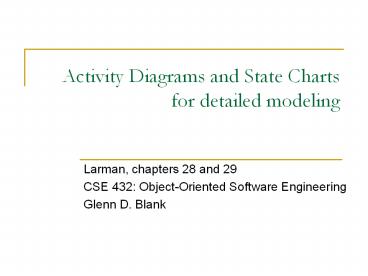Activity Diagrams and State Charts for detailed modeling - PowerPoint PPT Presentation
Title:
Activity Diagrams and State Charts for detailed modeling
Description:
OO design develops the analysis into a blueprint of a solution ... What does the Rake. symbol mean? When to use it? Fig. 28.5. Figure 28.6. State chart Diagrams ... – PowerPoint PPT presentation
Number of Views:291
Avg rating:3.0/5.0
Title: Activity Diagrams and State Charts for detailed modeling
1
Activity Diagrams and State Charts for detailed
modeling
- Larman, chapters 28 and 29
- CSE 432 Object-Oriented Software Engineering
- Glenn D. Blank
2
Goals of OO design
- OO design develops the analysis into a blueprint
of a solution - Where does the blueprint metaphor come from?
- OO design starts by fleshing the class diagrams
- Coad Nicola call this "the continuum of
representation principle use a single underlying
representation, from problem domain to OOA to OOD
to OOP," i.e., class diagrams - Reworks and adds detail to class diagrams, e.g.,
attribute types, visibility (public/private),
additional constraints - Looks for opportunities for reuse
- Addresses performance issues, both for system and
users - Designs UI, database, networking, as needed
- Designs ADT to describe the semantics of classes
in more detail - Develops unit test plans based on class diagrams
and ADT design
3
Activity Diagram - Figure 28.1
- Petri nets notation
- What are actions? Transitions?
- How does it support parallelism?
4
When to create Activity diagrams?
- Modeling simple processes or complex ones?
- Modeling business processes
- Helps visualize multiple parties and parallel
actions - Modeling data flow (alternative to DVD notation)
- Visualize major steps data in software processes
5
Activity diagram to show data flow model Notation
pros cons?
Figure 28.3
Figure 28.2
6
What does the Rakesymbol mean?When to use it?
Figure 28.6
Fig. 28.5
7
State chart Diagrams
- A State chart diagram shows the lifecycle of an
object - A state is a condition of an object for a
particular time - An event causes a transition from one state to
another state - Here is a State chart for a Phone Line object
state
initial State
event
transition
8
State charts in UML States in ovals,
Transitions as arrows
- Transitions labels have three optional parts
Event Guard / Action - Find one of each
- Item Received is an event, /get first item is an
action, Not all items checked is a guard - State may also label activities, e.g., do/check
item - Actions, associated with transitions, occur
quickly and arent interruptible - Activities, associated with states, can take
longer and are interruptible - Definition of quickly depends on the kind of
system, e.g., real-time vs. info system
9
When to develop a state chart?
- Model objects that have change state in
interesting ways - Devices (microwave oven, Ipod)
- Complex user interfaces (e.g., menus)
- Transactions (databases, banks, etc.)
- Stateful sessions (server-side objects)
- Controllers for other objects
- Role mutators (what role is an object playing?)
- Etc.
10
Case Study Full-Screen Entry Systems
- Straightforward data processing application
menu-driven data entry (see overhead) - Each menu comes with a panel of information
lets user choose next action - Interaction during a airline reservation session
- Enquiry on flights, information possible new
states - Meyer shows different ways to solve problem
- goto flow (50's),
- functional decomposition (70's)
- OO design (90's) improves reusability and
extensibility
11
Superstates (nested states)
- Example shows a super-state of three states
- Can draw a single transition to and from a
super-state - How does this notation make things a bit
clearer?
12
Concurrency in state diagrams
- Dashed line indicates that an order is in two
different states, e.g. Checking Authorizing - When order leaves concurrent states, its in a
single state Canceled, Delivered or Rejected
13
Classes as active state machines
- Consider whether a class should keep track of its
own internal state - Example from Bertrand Meyer first cut design of
LINKED_LIST class - class LINKABLET --linkable cells
- feature
- valueT
- right LINKABLET --next cell
- --routines to change_value, change_right
- end
- class LINKEDLISTT
- feature
- nb_elements INTEGER
- first_element LINKABLET
- value(iINTEGER)T is --value of i-th
element loop until it reaches the ith element - insert(iINTEGER valT) --loop until
it reaches ith element, then insert val - delete(iINTEGER) --loop
until it reaches ith element, then delete it - Problems with first-cut?
- Getting the loops right is tricky (loops are
error-prone) - Redundancy the same loop logic recurs in all
these routines - Reuse leads to inefficiency suppose I want a
routine search
14
Classes as active state machines (cont.)
- Instead, view LINKED_LIST as a machine with an
internal state - Internal state is information stored as
attributes of an object - What have we added to represent internal state?
- Cursor current position in the list
- search(item) routine moves the cursor until it
finds item - insert and delete operate on the element pointed
at by cursor - How does this simplify the code of insert,
delete, etc.? - Client has a new view of LINKED_LIST objects
- l.search(item) --find item in l
- if not offright then delete end --delete
LINKABLE at cursor - Other routines move cursor l.back l.forth
15
Key idea for OOD data structures can be active
- Active structures have internal states, which
change - Routines manipulate the object's state
- What other classes could be designed this way?
- Files, random number generators, tokenizers, ...
- Class as state machine view may not be obvious
during analysis - A good reason for redesign!































